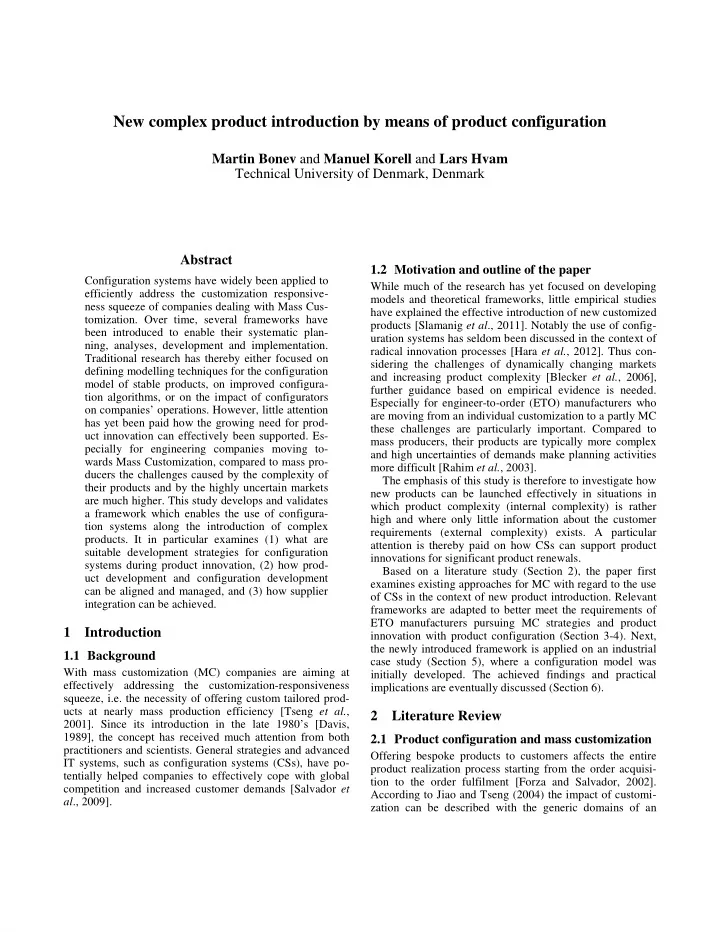

New complex product introduction by means of product configuration Martin Bonev and Manuel Korell and Lars Hvam Technical University of Denmark, Denmark Abstract 1.2 Motivation and outline of the paper Configuration systems have widely been applied to While much of the research has yet focused on developing efficiently address the customization responsive- models and theoretical frameworks, little empirical studies ness squeeze of companies dealing with Mass Cus- have explained the effective introduction of new customized tomization. Over time, several frameworks have products [Slamanig et al ., 2011]. Notably the use of config- been introduced to enable their systematic plan- uration systems has seldom been discussed in the context of ning, analyses, development and implementation. radical innovation processes [Hara et al. , 2012]. Thus con- Traditional research has thereby either focused on sidering the challenges of dynamically changing markets defining modelling techniques for the configuration and increasing product complexity [Blecker et al. , 2006], model of stable products, on improved configura- further guidance based on empirical evidence is needed. tion algorithms, or on the impact of configurators Especially for engineer-to-order (ETO) manufacturers who on companies’ operations. However, little attention are moving from an individual customization to a partly MC has yet been paid how the growing need for prod- these challenges are particularly important. Compared to uct innovation can effectively been supported. Es- mass producers, their products are typically more complex pecially for engineering companies moving to- and high uncertainties of demands make planning activities wards Mass Customization, compared to mass pro- more difficult [Rahim et al. , 2003]. ducers the challenges caused by the complexity of The emphasis of this study is therefore to investigate how their products and by the highly uncertain markets new products can be launched effectively in situations in are much higher. This study develops and validates which product complexity (internal complexity) is rather a framework which enables the use of configura- high and where only little information about the customer tion systems along the introduction of complex requirements (external complexity) exists. A particular products. It in particular examines (1) what are attention is thereby paid on how CSs can support product suitable development strategies for configuration innovations for significant product renewals. systems during product innovation, (2) how prod- Based on a literature study (Section 2), the paper first uct development and configuration development examines existing approaches for MC with regard to the use can be aligned and managed, and (3) how supplier of CSs in the context of new product introduction. Relevant integration can be achieved. frameworks are adapted to better meet the requirements of ETO manufacturers pursuing MC strategies and product 1 Introduction innovation with product configuration (Section 3-4). Next, the newly introduced framework is applied on an industrial 1.1 Background case study (Section 5), where a configuration model was With mass customization (MC) companies are aiming at initially developed. The achieved findings and practical effectively addressing the customization-responsiveness implications are eventually discussed (Section 6). squeeze, i.e. the necessity of offering custom tailored prod- ucts at nearly mass production efficiency [Tseng et al. , 2 Literature Review 2001]. Since its introduction in the late 1980’s [Davis, 1989], the concept has received much attention from both 2.1 Product configuration and mass customization practitioners and scientists. General strategies and advanced Offering bespoke products to customers affects the entire IT systems, such as configuration systems (CSs), have po- product realization process starting from the order acquisi- tentially helped companies to effectively cope with global tion to the order fulfilment [Forza and Salvador, 2002]. competition and increased customer demands [Salvador et According to Jiao and Tseng (2004) the impact of customi- al ., 2009]. zation can be described with the generic domains of an
Recommend
More recommend